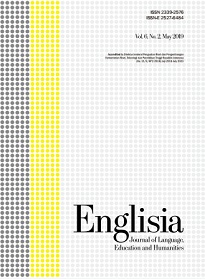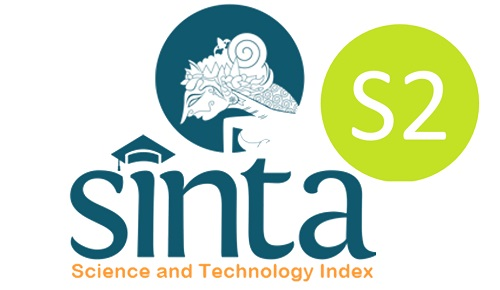IMPROVING STUDENTS’ LISTENING COMPREHENSION BY TEACHING CONNECTED SPEECH
DOI:
https://doi.org/10.22373/ej.v6i2.4565Keywords:
Listening, connected speech, improve, comprehensionAbstract
This present research was conducted in order to find out the improvement in students’ listening comprehension and to figure out whether students’ interest in listening class increases after being taught the aspects of connected speech. This research used a quantitative method with pre-experimental design, namely pre-test post-test involving only the experiment group. The population of this research was all the students of the eleventh-grade who are studying at MAS Darul Ihsan which amount to 184 students. In addition, the sample of this research was 30 students of class XI F that was chosen using purposive sampling. Moreover, this research used pre-test and post-test as well as questionnaires as data collection instruments. The research found that teaching connected speech in the listening classroom improved students’ listening comprehension. This was indicated by the comparison of t-score which is higher than t-table, (3.61 > 2.04). Therefore, the alternative hypothesis (Ha) was accepted and the null hypothesis (Ho) was rejected. Furthermore, the result of students’ response sheets indicated that students have positive perception toward the teaching connected speech and it can increase their interest in learning listening.
Downloads
References
Ahmadian, M., & Matour, R. (2014). The effect of explicit instruction of connected speech features on Iranian EFL learners’ listening comprehension skill. International Journal of Applied Linguistics & English Literature, 3(2), 227–236. doi 10.7575.
Ashtiani, F. T., & Zafarghandi, A. M. (2015). The effect of English verbal songs on connected speech aspects of adult english learners’ speech production. Advances in Language and Literary Studies, 6(1), 212-226. doi 10.7575.
Baghrahi, A. K., Shariati, M., & Tajadini, M. (2014). The effect of assimilation and elision teaching on listening comprehension of EFL junior high school students. International Journal of Language Learning and Applied Linguistics World (IJLLALW), 5(1), 264-273.
Bozorgian, H. (2012). The relationship between listening and other language skills in international English language testing system. Theory and Practice in Language Studies, 2(4), 657–663. doi 10.4304.
Bungin, B. (2005). Metode penelitian kuantitatif (komunikasi, ekonomi, dan kebijakan politik serta ilmu-ilmu social Lainnya). Jakarta: Prenada Media Group
Campbell, D. F., Meinardi, M., Mcdonnell, C., & Richardson, B. (2007). The need for a speech corpus. ReCALL, 19(01), 1-16. doi 10.1017.
Celce-Murcia, M., Brinton, D., & Goodwin, J. (1996). Teaching pronunciation: A reference for teachers of English to speakers of other languages. New York: Cambridge University Press.
Gilakjani, A. P., & Sabouri, N. B. (2016). Learners’ listening comprehension difficulties in English language learning: A literature review. English Language Teaching, 9(6), 123–133. doi 10.5539.
Khaghaninezhad, M. S., & Jafarzadeh, G. (2014). Investigating the effect of reduced forms instruction on EFL learners’ listening and speaking Abilities. English Language Teaching, 7(1), 159–171. doi 10.5539.
Mahmood, A., Khan, U., & Uzair, M. (2012). Improving listening skills through teaching assimilation and elision. International Journal of Physical and Social Sciences, 2(6), 365–376
Matsuzawa, T. (2006). Comprehension of English reduced forms by Japanese business people and the effectiveness of instruction. In J. D. Brown, & K. Kondo-Brown, (Eds.), Perspectiveson teaching connected speech to second language speakers (pp. 59-66). Honolulu, HI: University of Hawai‘i, National Foreign Language Resource Center.
Rahayuningsih, A. S. (2010) Improving students’ listening comprehension on narrative text: (a collaborative action research at the grade 10 students of sma). Sukarta: Sebelas Maret University
Saricoban, A. (1999). The teaching of listening. The Internet TESL Journal. 5(2)
Underhill, A. (2005). Sound foundations: learning and teaching pronunciation. UK: Macmillan Education
Ur, P. (1984). Teaching listening comprehension. Cambridge, NY: Cambridge University Press.
Downloads
Published
Issue
Section
License
Proposed Policy for Journals That Offer Open Access
Authors who publish with Englisia journal agree to the following terms:
- Authors retain copyright and grant the journal right of first publication with the work simultaneously licensed under a Creative Commons Attribution License that allows others to share the work with an acknowledgement of the work's authorship and initial publication in this journal.
- Authors are able to enter into separate, additional contractual arrangements for the non-exclusive distribution of the journal's published version of the work (e.g., post it to an institutional repository or publish it in a book), with an acknowledgement of its initial publication in this journal.
- Authors are permitted and encouraged to post their work online (e.g., in institutional repositories or on their website) prior to and during the submission process, as it can lead to productive exchanges, as well as earlier and greater citation of published work (See The Effect of Open Access).









